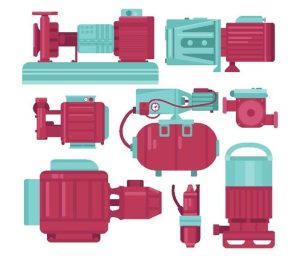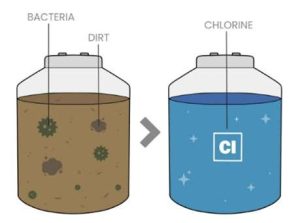Wastewater Management Plant Malaysia
Wastewater Management Plant 101
A wastewater management plant (also called a wastewater treatment plant, WWTP) is a facility designed to treat and purify water that has been contaminated by human, industrial, or commercial use before releasing it back into the environment or reusing it. The goal is to remove pollutants, pathogens, and harmful chemicals to protect public health and ecosystems.
The required level of wastewater treatment depends on multiple factors, including local environmental considerations and regulatory requirements. More stringent treatment is generally required for discharge into pristine environments or drinking water supplies compared to industrial or agricultural reuse.
Pumps in Wastewater Systems
 When wastewater can’t flow by gravity due to low elevation or terrain, pumping stations lift it to higher ground. These stations use non-clogging pumps to handle raw wastewater and are housed in lift stations, which come in two main types, wet-well stations and dry-well stations.
When wastewater can’t flow by gravity due to low elevation or terrain, pumping stations lift it to higher ground. These stations use non-clogging pumps to handle raw wastewater and are housed in lift stations, which come in two main types, wet-well stations and dry-well stations.
For wet-well stations, a single chamber holds sewage, with submersible pumps operating underwater. On the other hand, dry-well stations have two chambers that separate wastewater from pumps, allowing easier maintenance. We recommend that every wastewater management plant has at least two pumps, ensuring continuous operation if one fails.
Flow Rates
Wastewater flow fluctuates significantly throughout the day due to factors such as population, water usage, and industrial activity. A well-designed system must handle these variations to ensure efficient treatment and prevent overflow.
Wastewater Treatment and Disposal
The design of a wastewater treatment system depends on the expected sewage volume from homes, businesses, and industries, including inflows and infiltration (I&I). The choice between on-lot, clustered, or centralized treatment primarily depends on demand factors, site conditions, and wastewater composition, besides practical considerations such as technology, energy use, and maintenance costs. Efficient wastewater management plants balance performance, cost, and compliance with environmental standards.
Wastewater treatment is essential to protect both human health and the environment. Before being discharged or reused, wastewater must undergo purification to remove harmful contaminants. This includes eliminating suspended solids and biodegradable organic matter that can deplete oxygen in water bodies, as well as destroying pathogenic bacteria that cause diseases.
Additionally, treatment often requires removing excess nutrients like nitrates and phosphates, which can lead to algal blooms and ecosystem imbalances. Industrial wastewater often contains toxic chemicals that must be neutralized or removed to prevent environmental damage. Through proper treatment processes, we can ensure water safety, preserve aquatic life, and maintain the overall quality of our water resources.
Treatment Process

Water treatment done by wastewater management plants typically happens in three stages : Primary, Secondary, and Tertiary treatment. First, wastewater passes through screens that catch large debris like plastics and rags, and then moves through grit chambers where sand and gravel settle out.
This preliminarily treated water then flows into primary clarifiers, where it is held quietly to allow heavier organic solids (sludge) to sink to the bottom and lighter greases (scum) to float to the surface for removal. This primary stage eliminates a significant portion of the suspended solids.
The clarified water then undergoes secondary treatment, where microorganisms are introduced in aeration basins to consume the dissolved organic pollutants. This biological process is followed by a final settling tank where these microorganisms clump together and settle out.
The now-cleaned water undergoes a final polishing stage, or tertiary treatment, which almost always includes disinfection (using chlorine, UV light, or ozone) to kill any remaining pathogens before the clean effluent is safely released back into the environment.
 The Final Product: Where Does the Water Go?
The Final Product: Where Does the Water Go?
The cleaned water, now called effluent, is finally released into a local river, stream, or ocean. In some cases, it is further purified for water reuse (or reclamation) for purposes such as irrigation, industrial cooling processes and replenishing groundwater aquifers (groundwater recharge).
Compliance
In Malaysia, The central authority for enforcement is the Department of Environment (Jabatan Alam Sekitar or JAS) under the Ministry of Natural Resources and Environmental Sustainability. Industries and wastewater treatment plants must obtain a license from JAS and conduct self-monitoring, submitting discharge data regularly. Compliance is taken seriously, with significant penalties, including heavy fines and imprisonment, for violations that lead to environmental pollution.
Cubictech provides comprehensive, integrated solutions for wastewater management plants, handling every stage from initial concept to final commissioning and beyond. Contact our team today to discuss your specific project needs.
We also distribute products such as industrial process pumps, process equipment, sensor and instrument, analyser system, chlorination equipment and filtration equipment.
Due to our extensive network in sourcing products and equipment, we also have a strong global procurement team helping our clients to source specialty products. In the event that our clients are sourcing for good quality products but at a competitive pricing, we also have our own in-house brand, DeTitan to cater for their demand. Besides, we also help our clients to do rebranding so they are perceived as more professional and environment-friendly.
Related Articles
- Chemical Dosing Skid And Manifold Malaysia
- Chemical Process Tank Malaysia
- Commercial Reverse Osmosis System Malaysia
- Commercial Wastewater Systems Malaysia
- Commercial Water Treatment System Malaysia
- Factory Waste Treatment Malaysia
- Gas Chlorination Systems Malaysia
- Industrial Effluent Treatment System (IETS) Malaysia
- Industrial Filter And Screens Malaysia
- Industrial Wastewater Solution / Systems Malaysia
- Industrial Water Purification Systems Malaysia
- Johnson Wedge Filter (Customized Filter) Malaysia
- Sewage System Malaysia
- UV Industrial Water Treatment Malaysia
-
- Well Filtration System Malaysia
- COB BOD Reduction Parameter Malaysia
- Department Of Environmental (DOE) Water Standard Submission Malaysia
- Industrial Water Treatment Malaysia
- Wastewater Engineering and Construction Malaysia
- Wastewater Management Plant Malaysia
- Water Treatment and Recycling Malaysia
- Effluent Treatment Plant Malaysia
- Heavy Metal Water Treatment Malaysia
- Industrial Reverse Osmosis System Malaysia
- Industrial Ultrafiltration (UF) System Malaysia
- Industrial Wastewater Treatment Malaysia
- Industrial Water Filters Malaysia
- Municipal Water Treatment System Malaysia
- POME Treatment Malaysia
- Portable Container Treatment System Malaysia
- Residential Water Treatment Malaysia
- Sealless Magnetic Drive Pump Malaysia
- Sewage Treatment Plant Malaysia
- Titanium Water Filter Cartridge Malaysia
- Water Treatment Automation Dosing System Malaysia
- Piping Tank Fabrication Installation Works Malaysia
- Wastewater and Water Treatment Design and Build Malaysia
- Wastewater Treatment Plant Design / Build / Commissioning Malaysia
- Wastewater Treatment Process Instruments Malaysia
- Water & Wastewater Treatment Malaysia
